Alpha onder de loep – deel 3
‘Crisis alpha’ kan uitgesplitst worden in crisis beta en negatieve alpha.

‘Crisis alpha’ kan uitgesplitst worden in crisis beta en negatieve alpha.

Dit artikel is alleen in het Engels beschikbaar.
In the first part of this series on the sources of investment returns and how to capture them effectively and efficiently, we introduced our alternative approach:
The only source of (positive) returns is beta. And since ultimately risk premiums are the only sustainable source of investment returns, at the basis of every source of beta, there is one (or more) source of risk. If all sources of beta are properly taken into account, the only alpha remaining will be a negative alpha, resulting from inefficiencies in capturing the beta aimed for.
Some sources of beta are harder to capture than others. Or, to put it differently, the harder-to-capture types of beta require more skill than the easily-captured types of beta. But despite the skill required, it all remains beta.
If positive alpha cannot be acquired, then what about the ‘crisis alpha’ that trend following strategies like our Diversified Trend Program (DTP) are supposed to deliver? Our alternative approach to alpha and beta suggests that this ‘crisis alpha’ can be decomposed into a crisis beta that is embedded in a diversified trend following approach, and a negative alpha which, if not controlled effectively, can grow large in crisis environments. In this third and final part of the series we will discuss both of these components.
A crisis is to a trend following strategy what a storm is to a boat sailing the seas: the wind can propel the boat forward, but the boat and its crew have to be able to handle that very same wind.
‘Crisis alpha’ generally refers to the type of crisis that is accompanied by declining global stock markets. Why would trend following strategies perform well in such environments? One often suggested explanation is that these strategies can go short. So, when stocks decline, they are presumed to be short equities to profit from the decline.
This story may sell well, but in our experience it isn’t very accurate. For one thing, when equity markets sell off for one or two weeks during a long-running uptrend, a medium to long term trend following strategy will typically be long stocks. And it will lose money on that position, just like any other strategy that is long in a declining stock market.
Trend following CTAs did in fact perform strongly during many past crises. The Asian crisis in 1997, the Russian crisis in 1998, the collapse of the Dot-com bubble in 2001/02 and the Credit Crisis in 2007/08 immediately come to mind. What was really driving this performance?
Having navigated the markets for over 25 years with DTP, we experienced that a key element is that the program does not only trade futures on stock markets, but also on currencies, interest rates and commodities. In addition, and just as important, it does so in a fully integrated way. Simply because these markets are not disconnected entities. They are all part of the same world, subject to developments in the same society.
In our July 2013 article Hay fires and self-heating we explained that a global crisis generally doesn’t come out of thin air. It normally starts with a local problem in some part of economy, which then escalates and affects global stock markets. We illustrated this mechanism with the example of the Russian crisis, which started with a long-running downtrend in the oil price dragging down Russian markets before it triggered a sharp sell-off in developed market equities in the summer of 1998.
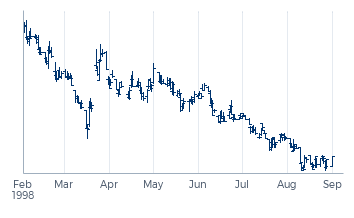
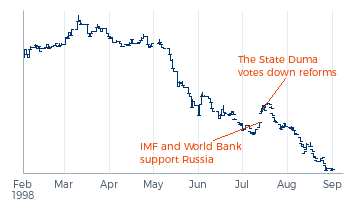
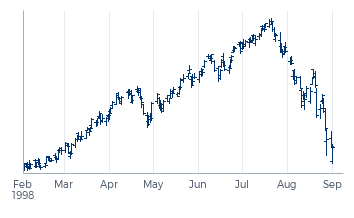
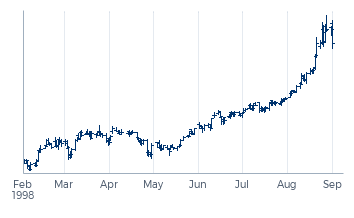
Somewhat comparable, the Credit Crisis – which started on 27 February 2007 with the announcement that Freddy Mac would stop buying risky home loans – had been driving up Treasury bond prices since the summer of 2007 before it really hit global stock markets in October. DTP performed strongly in both of these crises, not so much by being short stocks, but above all by being sizably positioned in or near the sources of these crises before they escalated: short oil markets in 1998 and long treasuries in 2007. During the Credit Crisis, only in 2008 − when the Credit Crisis deepened − was DTP also sizably short global stocks.
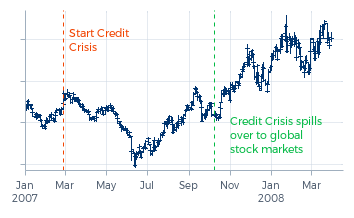
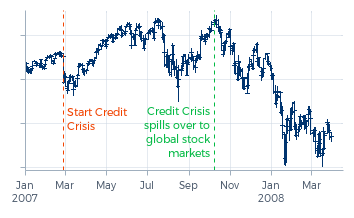
This immediately explains in what scenarios a diversified trend following strategy is most likely not able to profit from a crisis in equity markets: either when a crisis starts with a sharp market reaction from within the center of the global stock markets, or when a crisis starts with an escalating development in a part of the economy in which the strategy is not sizably positioned.
While little can be done to protect the strategy against the first scenario, including as many markets as possible in the strategy’s trading universe used to be an effective defense against the second scenario. But due to various developments in the markets and in society, the correlation structure between markets has changed such that just adding more markets doesn’t do the trick anymore. We’ve experienced that a more targeted approach is now required to get and stay sizably positioned in enough truly different trends. Failing to adapt to this new reality means that a trend following strategy likely won’t be sizably invested in the trend that will escalate into the next crisis. This doesn’t mean that the crisis beta embedded in a diversified trend following strategy has diminished; it just means that this beta has become harder to capture.
A more targeted approach is now required to get and stay sizably positioned in enough truly different trends.
However, also during the abovementioned crises it did not turn out to be that obvious to avoid a significant amount of negative crisis alpha when capturing this type of beta. This explains the large dispersion in performance of even highly correlated trend following CTAs during these periods. And it also explains why the largest positive ‘crisis alpha’ in these periods is advertised by managers that only show hypothetical returns. No crisis skill is required as long as you don’t really trade in challenging market environments.
But before we discuss this topic in more detail, let’s address a somewhat more philosophical question on crisis beta first. In our alternative approach we attribute all sustainable investment returns to beta, and we claim that at the basis of every source of beta, there is one (or more) source of risk. Can profiting from declining stock markets actually be regarded as receiving a risk premium? Aren’t the investors who are long stocks the ones carrying the market risk?
Indeed, in normal market environments, conscious investors are much like entrepreneurs looking for firms with a bright future. They buy stocks to participate in the success of the firms they believe in, fully aware of the enterprise risks and market risks involved. The returns on their investments can be regarded as risk premiums.
During bubbles, though, more and more investors are buying stocks primarily for fear of not participating in the ongoing gold rush that already made other people rich. Such investors are implicitly willing to pay a (large) premium to avoid that risk. This premium fuels the bubble. And when the bubble bursts, this risk premium is received by those investors who shorted (futures on) these stocks. A large part of DTP’s returns in 2001 and 2002 can be seen as this type of risk premium. But also in this particular crisis, risk premium wasn’t just collected through short positions in stock markets.
According to our alternative approach, negative alpha results from inefficiencies in capturing the beta aimed for. Crisis environments typically offer more operational challenges for executing an investment strategy than normal market environments. This does not only hold for crises accompanied by longer-term downtrending global stock markets, but also for the shorter-term and/or more local type of crisis events such as those arising from acts of nature or human aggressors. And these operational challenges can, if not handled well, result in significant negative alpha, i.e. negative crisis alpha.
An example of such a challenge is the (threat of a) default of a counterparty. A loss of cash held at a defaulting bank or money market fund would not be classified as negative alpha. In fact, this is an example of getting hit by the occurrence of an unanticipated or underestimated risk factor, as we explained in the first part of this series. But if the (threat of a) counterparty defaulting would constrain the manager in executing his strategy, this can definitely result in negative alpha. For example, at the height of the Credit Crisis in 2008 it was a piece of cake to detect trends in currency markets. Getting OTC-positions in these trends cleared, however, became a serious challenge because counterparties wouldn’t automatically accept transactions anymore from counterparties they used to trust.
Other operational challenges typical for crises arise from crisis measures invoked overnight by exchanges, regulators or governments, such as a short-selling ban, the extended close of an exchange or other measures that hinder trading. In the wake of the Asian crisis in 1998, for instance, Malaysian President Mahathir imposed strict capital controls overnight. At that moment, DTP was holding various profitable positions in trends in Malaysian markets. How to prevent money from being stuck in a country is an operational challenge that no backtest or simulation will ever prepare you for.
Such crisis interventions highlight something that is often downplayed by systematic investment managers: a huge discretionary component. But interpreting an overnight change to the playing field and swiftly adapting to it is of course highly discretionary. The choices made in these situations ultimately determine the amount of negative crisis alpha that will be incurred.

Most of the operational challenges mentioned here involve some type of liquidity issue. Such and other liquidity issues frequently emerge in crisis environments. Essentially, this only causes problems for those investors who really want to trade. For that reason, when these issues occur it is most evident that crisis beta and crisis alpha act as two directly opposite factors. An investor who is short stocks in a collapsing stock market makes a profit or, expressed in our terminology, receives a positive crisis beta. An investor who sells stocks in a collapsing stock market pays a large liquidity premium – one of the most important sources of negative crisis alpha.
Why do investors actually sell in a collapsing market? Or buy in an exploding market? In many cases: because they think they have to. This conviction seems to be increasingly dictated by external or self-imposed rules. (If we go to the heart of the matter, we will typically find rules that are based on the assumption of liquidity, but that are just as rigorously applied in the absence of liquidity.) This vulnerability to rule-dictated negative crisis alpha not only applies to investors with a systematic trading approach such as ourselves. It can just as easily be embedded in, say, the risk management process of other trading styles. For instance via a too rigorous application of a VaR-methodology that overreacts to large price moves, which can lead to (unnecessary) transactions against a large liquidity premium and a potentially large opportunity loss – another form of negative alpha.
Operational challenges and liquidity issues are the most important sources of negative crisis alpha.
Although some trading styles, by nature, are more sensitive to negative crisis alpha than others, most of this sensitivity is not style-specific. It is mostly the result of operational choices. The number-one requirement for avoiding negative crisis alpha is therefore to be in complete operational control. The more an investment manager is dependent on third parties and the stricter it is limited by rigid guidelines, the more vulnerable it will be in crisis environments. A manager can only manage if it is able and capable to do what the (exceptional) circumstances call for.
This ability to act is among others governed by the manager’s change management policy. Is this policy written from the perspective that implementing changes constitutes a source of risk and does it require changes to be thoroughly tested before they are implemented? Or is it based on the notion that an organization needs to be able to make changes promptly whenever necessary? We believe that the first approach offers a sense of safety in normal environments, whereas the second approach is crucial to avoid negative alpha in times of crisis.
This required flexibility brings us back to discretion. Why would systematic managers and their allocators frown upon the use of discretion? Probably because they realize or even have experienced that it’s a double-edged sword – the use of discretion in itself can also be a major source of negative alpha, especially in a crisis environment. We started this series by stating that risk premium is the only sustainable source of investment returns. An environment with more risk naturally offers more opportunities – more beta – for an investment strategy aimed at harvesting the associated risk premium. But that beta will only be fully captured by those managers that, when push comes to shove, don’t shy away from this risk. Reducing position sizes around crisis events, for instance, is a sure way to drag down your crisis beta with some negative crisis alpha.
The desire to avoid this type of negative alpha is no justification for the exclusion of discretion. What is really required is that the ultimate decision makers possess all the necessary know-how and, even more important, the know-why behind their investment program – and especially behind its operational aspects – to be confident that it will successfully navigate any challenging environment. If a captain doesn’t fully trust his boat and his crew, he will not be able to sail it through rough waters.